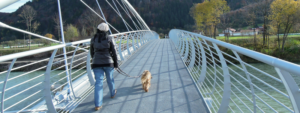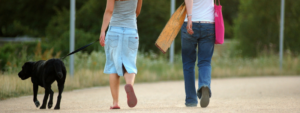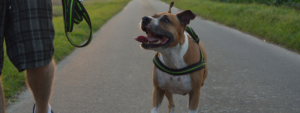Leash Training a Puppy Like toy breeds, puppies are delicate, and their bodies are still developing. If a handler isn’t careful, their pup can easily injure themselves. Unfortunately, dogs like to pull; puppy pulling can cause damage to the trachea.

For this reason, it’s best to attach your pup’s leash to a harness when they are little wee-ones (the same goes for toy breeds)! If the training procedures I’m about to list are done properly, your pup won’t pull, regardless of whether their leash is attached to a harness or collar.
- If Used Correctly, slip collars (popularly labeled ‘choke chains’) are useful tools for training a larger adult dog, but shouldn’t be used on developing puppies!
- People sometimes say ‘harnesses can encourage pulling. This is true only because harnesses remove pressure from the neck and trachea; solid training techniques will have your pup walking smoothly no matter what they wear.
Introducing Your Puppy to the Harness
If you are going to walk your pup with a harness (which I advise for puppies), introduce it to him/her. Let your pup wear their harness during short periods of playtime; try to make sure your pooch relates positive experiences to the harness. Make sure the association is made- ‘Harness time means fun!’
Be sure your little ‘fur-kid’ doesn’t relate any anxiety to the harness, or you might soon be left with multiple chewed-up bits of the harness. That could soon become rather pricey!
Perfect Leash Training
Puppy Leash Training Method Number One:
- To best use this method, your dog must first know the ‘sit’ and ‘recall (come when called)’ commands.
So, you’re standing next to your puppy dog (4-6 foot lead attached). First step is a go! Begin walking along. As soon as your pup starts to pull, immediately stop the walk, call them back to you, and command them to sit. Don’t start walking again until they are calmly seated.
Of course- all dogs love their walks! By stopping, you take that ‘adventure’ away from them. Eventually, he/she will catch on to the fact that ‘pulling causes the walk to stop, and the only way to keep going is not to pull’.
g to take patience; it’s certainly not going to come overnight. Rather- it could take weeks for your puppy to become a pro walker. Over time, you’ll notice your pup begin to pull less and less, until finally- barely at all!
Puppy Leash Training Method Number Two:
The second method here is perhaps the best leash training method used today! All you will need is a pouch full of treats (preferably small training rewards). As with method one, start walking.
Every 2-3 steps, ‘pop a treat’ for your pup. Before long, your little pet will be walking right by your side, anticipating that treat!
You’ll want to slowly lengthen the duration between treats. For example, the first 2-3 walks is every 2-3 steps, then every 5-6, then every 10, etc. Don’t move too quickly; make sure the dog is always attentive to you and waiting for that reward.
- Professional show dog trainers use this method to establish that absolute perfect walking technique you see on TV!
Training the Recall
Pick a command word; something not often used but simple, like perhaps “Here”, would work great! Now, with your puppy in front of you, speak the word and offer a small treat simultaneously. It won’t take long before the association is made- ‘When he says ‘Here’, I get a treat!’
Slowly increase training distance. For example, stand to feet away, and speak the command word; as your pup runs up to you, offer a treat. To them, ‘here’ means you’re going to give them a treat, rather than ‘he wants me to come to him’. The incentive is important.
Move on to the next stage; call them from around corners, or other rooms (not within their line of sight). Keep in mind, you want to continue training this every so often for as long as you own your pup, even if that may be once or twi a week as they age.
Don’t continue this for hours at a time, but perhaps 5-7 repetitions at first. If you repeat this countless times at once, feeding them a treat every time, the rewards will eventually lose their value.
Consistency and Reinforcement

It is extremely important in any training regimen to be consistent. Do the same thing, every time! If you are going to choose a training method listed above, stick with it. If you are going to reward your dog, reward your dog every time (given you can span out the rewards in this circumstance).
Don’t vary your training methods unless you have determined one not to be effective at all. Switching around can confuse your pet. Also- dogs learn by the very idea of repetition; they aren’t going to pick up on a concept the very first time you introduce it.
Through consistent repetition, you are conditioning your dog to perform a certain behavior!
Positive Punishment and the Slip Collar
‘Positive Punishment’ refers to adding an undesirable effect to decrease a behavior; the ‘positive’ referring to nothing but addition. Most people mistakenly refer to this as negative reinforcement; the term simply indicates you are reinforcing a behavior by taking something away.
I firmly believe slip collars shouldn’t be used with developing puppies, but for the sake of this article-
The idea here is that the loop constricts when the dog pulls, discouraging pulling. Also, the collar should tighten and immediately loosen (if worn correctly), offering an instantaneous correction.
- Check here for the proper way to apply a slip collar.
Puppy Leash Biting: Stop the Madness!
One way dogs release pent up energy and stress is by mounting, tugging or jumping (in this case, tugging). Does your pet seem overly excited to embark on his walk? This could also be an attempt at drawing attention. In some cases, your pet might relate anxiety to his leash, and try to chew it up. It’s not easy to determine exactly which is ‘your’ case without observing your pup, but I’m sure you’ll be able to determine the cause here.
Stop the Chewing
But- how do you stop your pup from pulling on the leash during his walk? The best way to tackle this problem is probably to calm your dog. If that doesn’t work, you could use the same method I spoke of above; stop the walk. Did you ever train your pup the ‘drop it’ command? Pet stores also sell sprays meant to prevent dogs from inserting things into their mouths.
Teach your pooch to sit; wait until he/she has calmed down to attach the leash to collar/ harness. If the pup bites the leash, stop what you are doing until he releases it.
- Don’t get into a ‘tug of war’ match! The more you pull, the more likely your pup is to tug right back!
Why Puppies and Dogs Pull

Puppies pull on their leashes for a number of reasons, but it is important to keep one thing in mind; slowing down and walking calmly beside you doesn’t come natural to a dog. Dogs walk faster than humans, and are easily distracted.
What should you do about this? If leash walking method number two listed above doesn’t have your pups’ attention squarely fixed on you, then add praise! Become more exciting than any other possible distractions.
Types of Leashes & Best Practices
There are many types of leashes available on the market, but there is no one ‘perfect overall’ lead. All of the various types have their places; some do better in certain circumstances, where those same ones may not do so well in other areas.
Leather Leash
During training exercises, a 4-6 foot leather lead is perhaps one of the absolute best choices for leash training a puppy! Not only is leather much easier on the hands than nylon or metal chain, it looks attractive. If you are willing to spend a little extra early on, this is probably the type you want!
On the other hand, leather tends to grow brittle when wet or with age. Though this type may look the best or be the most comfortable, it is also the type with the shortest life span.
Chain Link Leash
Strength isn’t a problem if you are dealing with a small puppy, but in the case of those few breeds apt to outweigh an adult human handler, (for ex. Mastiffs, Newfoundlands, St. Bernards), or even the muscular bulldogs, it can quickly present one. If you plan on walking a dog this size without precise training, you better hope your choice of leash is a strong one.
When it comes to strength, the metal chain link lead easily surpasses its’ competition. Even so, a wise handler must keep in mind- different circumference links are built to handle different amounts of pressure; a tiny ‘flower pot’ chain wouldn’t even compare to wet leather. If you are dealing with a giant breed, these links can become somewhat heavy. Metal can also be prone to rust after time, and certainly isn’t easy on the hands.
Extendable ‘Flexi’ Leash
The dog park is where the extendable lead shines! As long as ‘foot traffic’ isn’t presenting an obstacle, these leads allow you to let your pooch wander well beyond the standard recommended 4-6 ft. leads. Allow your pup the freedom to jump around, grab that frisbee, or trot off some energy!
These leashes are normally adjustable; handlers can usually decide whether to let them out or set the ‘brakes’ at 6 feet or so. However, the ‘foot traffic’ I mentioned above can become a problem; the wiry ‘flexi-lead’ can easily end up wrapped around your legs.
Use your best judgement if leash training a puppy with one of these.
Nylon Leash
Are you the type of owner that simply must stand out with the most attractive, colorful leash available? In that case, nylon leashes are for you! Coming in any number of colors, these guys are certainly apt to draw an eye.
On the other hand, nylon leashes can leave pretty nasty ‘leash burns’ on human handlers, even cut into the skin. Imagine a paper-cut, but the width of a piece of cardboard- it isn’t a pretty sight. If your pet is a strong puller, this might not be the best idea for you.

Electric ‘Shock’ Collar
This is another tool with a bad reputation, and well- deserved. A surprising number of handlers that utilize this tool misuse it, sometimes going as far as shocking their poor pup if he doesn’t respond THIS INSTANT. Unfortunately, that misuse can install a sense of fear in your pup, and fearful dogs are prone to act defensively (bite their handlers).
Today’s ‘E- collars’ are capable of painless vibrations and sounds, merely meant to help get the dog’s attention. Even so, the ‘Positive Punishment’ (mentioned above) of a mild electric ‘shock’ is far preferable to death by traffic fatality; there is absolutely no reasonable argument that any responsible handler on earth could make otherwise. Just- use this tool sparingly, and don’t misuse it.
Teaching Your Dog to Fear the Road
If done correctly, a wise handler might administer a slight ‘shock’ or alerting ‘buzz’ every time his pup comes too close to the road. The dog would eventually make the association- ‘road means shock’, and avoid it. For this to work, it’s important your dog thinks the road is administering the shock (much like an ‘electric fence’), and not you.
But- how will I ever get my dog to go with me on walks, or leave my yard in general, you ask? You teach your pup boundaries. Feel free to check out this great article on flag training and boundaries!
- If you’re still against the idea of a ‘shock collar’, I hope you have done your research, and discovered other means to keep your dog from running out in front of a car in the middle of the road.
- I only recommend the use of ‘Punishment’ in this manner for potentially deadly situations, not simply because you are too lazy to teach a proper recall!
